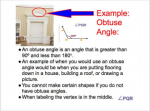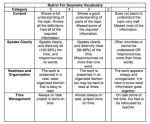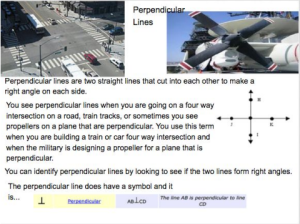Unit Goals
Unit Objectives
1. Identify points, rays, lines and segments using words and symbols.
2. Identify intersecting and parallel lines.
3. Identify angles by vertex and ray.
4. Identify Geometric Shapes
5. Knowing how to use perimeter, area, surface area, and volume
Background and Rationale
Learning Geometry is an important part of math. It is a great way to show kids how math works in the real world and why what they are learning is important. While doing this lesson the students will discover that geometry is all around them and that without geometry we would have a hard time doing a lot of things. The students will research Geometry Vocabulary that the teacher assigns them. They will make a Google slide for their words and added it to the Google slide show. At the end of the project the students will present their words to the class.
Lesson Objectives
Objective |
Bloom’s Verb |
|---|---|
|
Apply the concepts and steps in solving the problems. |
Applying |
|
Brainstorm ideas for their vocabulary words |
Remembering |
|
Develop slides that have all the information about their vocabulary words |
Creating |
|
Use their information that they have learned to use in their classroom and activities outside of class. |
Applying |
| Provide peer feedback on posted examples | Evaluating |
|
Use feedback from peers and teacher |
Applying |
Bloom’s Taxonomy
Creating (highest level)
Common Core / State and District Standards
1. Clear, understandable, and consistent
2. Based on rigorous content and the application of knowledge through higher-order thinking skills
3. Built upon the strengths and lessons of current state standards
Technology Integration (ISTE Standards•S)
Creativity and innovation
Students demonstrate creative thinking, construct knowledge, and develop innovative products and processes using technology.
- Apply existing knowledge to generate new ideas, products, or processes
- Create original works as a means of personal or group expression
- Use models and simulations to explore complex systems and issues
- Identify trends and forecast possibilities
Technology operations and concepts
Students demonstrate a sound understanding of technology concepts, systems, and operations.
- Understand and use technology systems
- Select and use applications effectively and productively
- Troubleshoot systems and applications
- Transfer current knowledge to learning of new technologies
Learning and Innovation Skills (P21.org)
Creativity and innovation
Think Creatively:
-
Use a wide range of idea creation techniques (such as brainstorming)
-
Create new and worthwhile ideas (both incremental and radical concepts)
-
Elaborate, refine, analyze and evaluate their own ideas in order to improve and maximize creative efforts
Work Creatively with Others:
-
Develop, implement and communicate new ideas to others effectively
-
Be open and responsive to new and diverse perspectives; incorporate group input and feedback into the work
Reason Effectively:
-
Analyze how parts of a whole interact with each other to produce overall outcomes in complex systems
Make Judgments and Decisions
-
Effectively analyze and evaluate evidence, arguments, claims and beliefs
-
Analyze and evaluate major alternative points of view
-
Reflect critically on learning experiences and processes
Communicate Clearly
-
Articulate thoughts and ideas effectively using oral, written and nonverbal communication skills in a variety of forms and contexts
Collaborate with Others
-
Demonstrate ability to work effectively and respectfully with diverse teams
Life and Career Skills (P21.org)
Creativity and innovation
Think Creatively
- Use a wide range of idea creation techniques (such as brainstorming)
- Create new and worthwhile ideas (both incremental and radical concepts)
- Elaborate, refine, analyze and evaluate their own ideas in order to improve and maximize creative efforts
Work Creatively with Others:
- Develop, implement and communicate new ideas to others effectively
- Be open and responsive to new and diverse perspectives; incorporate group input and feedback into the work
Reason Effectively:
- Analyze how parts of a whole interact with each other to produce overall outcomes in complex systems
Make Judgments and Decisions
- Effectively analyze and evaluate evidence, arguments, claims and beliefs
- Analyze and evaluate major alternative points of view
- Reflect critically on learning experiences and processes
Communicate Clearly
- Articulate thoughts and ideas effectively using oral, written and nonverbal communication skills in a variety of forms and contexts
Collaborate with Others
- Demonstrate ability to work effectively and respectfully with diverse teams
Be Self-directed Learners
- Go beyond basic mastery of skills and/or curriculum to explore
- expand one’s own learning and opportunities to gain expertise
Be Flexible
- Incorporate feedback effectively
- Deal positively with praise, setbacks and criticism
Information, Media, and Technology Skills (P21.org)
Create Media Products
-
Understand and utilize the most appropriate media creation tools, characteristics and conventions
Apply Technology Effectively
-
Use technology as a tool to research, organize, evaluate and communicate information
-
Use digital technologies (computers, PDAs, media players, GPS, etc.), communication/networking tools and social networks appropriately to access, manage, integrate, evaluate and create information to successfully function in a knowledge economy
Materials
1. Google Slides: This is where the student will put their work.
2. The internet where they will research their words. (This needs to be monitored by the teacher.)
- Plane: http://www.mathsisfun.com/geometry/plane.html
- Symbols you need to know: http://www.mathsisfun.com/geometry/symbols.html
- Website that will help: http://www.mathsisfun.com/geometry/plane-geometry.htm
- Great dictionary to use: http://www.mathsisfun.com/definitions/index.html
3. Thinking Routine: Creative Hunt
Lesson – Introduction
Geometry Vocabulary
Directions: Create a new slide for each term. There should be no cutting and pasting and all writing should be in your own words. Each slide must contain the requirements below:
- Term
- Picture
- Definition
- When would you use this term?
- How do you identify it?
- How do you label it?
- Does it have a symbol?
Lesson Activities and Procedures
| The Activities and Procedures | Time |
|---|---|
| The student will get assigned their vocabulary words. The teacher will go over the directions. The students will spend the rest of the time creating their slides. As the students are creating their slides, the teacher, and their peers will be giving feedback. |
(2) 50min classes. |
| The students will present their findings. | 50 min class. |
Lesson Closure
The students will present their findings. They will have the slide show available to them throughout the rest of the geometry unit.





